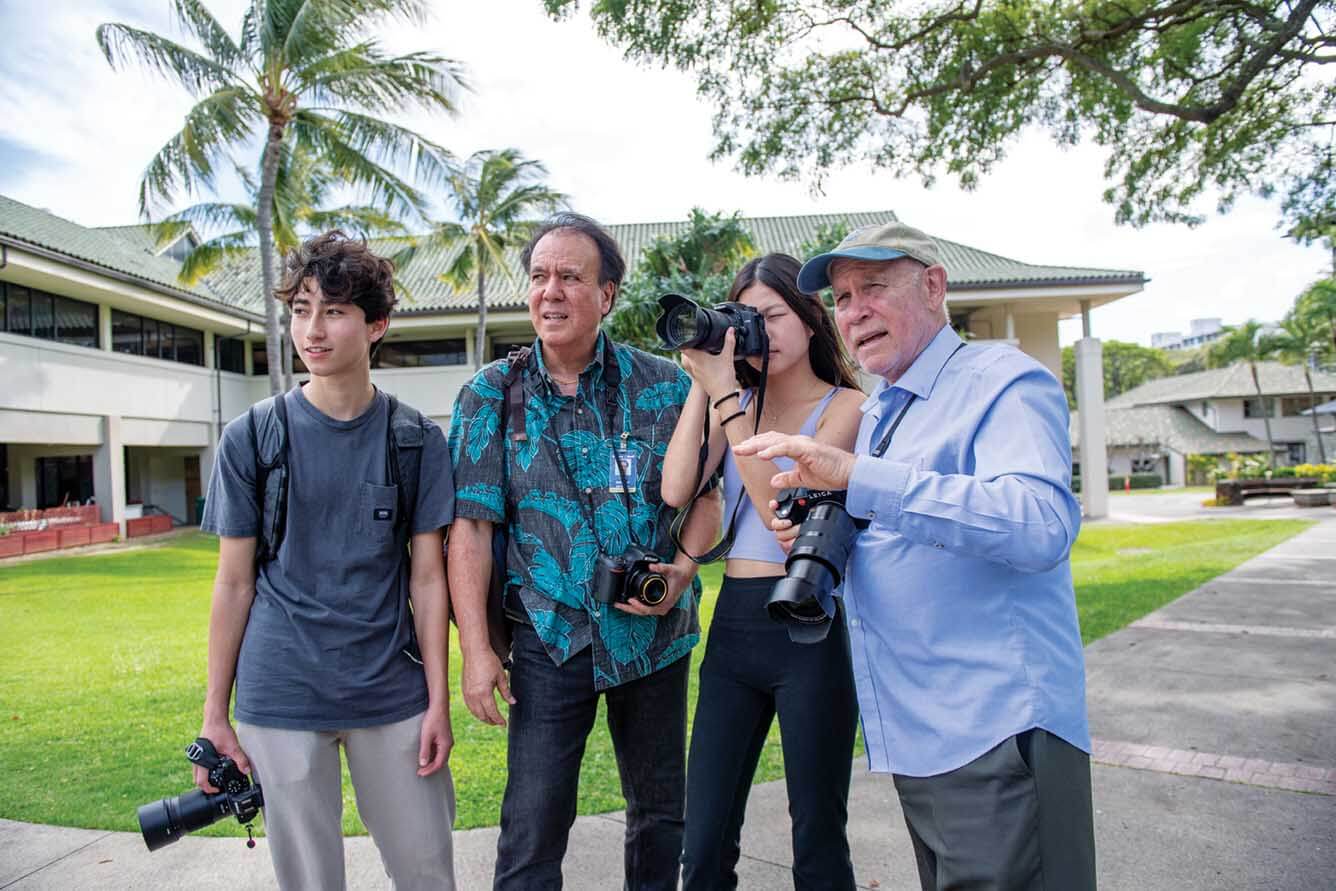Above: Steve McCurry in the field with photography students in Alex Selarque’s class.
When Alex Selarque learned that famed photographer Steve McCurry would be visiting Punahou in March, he jumped into action. “There’s no one like him,” says Selarque, who has taught fine art at Punahou since 1996. “He really knows his craft and is one of the most respected photographers in the world.”
He quickly began thinking about how McCurry’s visit could be used to improve the skills of students in his advanced photography course. It would be a great challenge for the young photographers. McCurry’s use of light and color is unmatched – not to mention his keen ability to create portraits that capture the essence, hardship and culture of a subject.
Imitating technique is one thing. That can be achieved if you study the work of a master carefully and exercise enough care. But the intangible gift of conveying the complexity of a subject and connecting the viewer to far-flung places and cultures that is omnipresent in McCurry’s work – that is the real problem.
The class rose to the challenge. “His visit was an inspiration to design an assignment specifically related to the master photographer’s work,” says Selarque. Students began by choosing one of McCurry’s water-themed images, which provide insight into human experiences in places like Madagascar, Venice and Myanmar. As a tribute or master study, students were asked to draw inspiration from the photo that meant something to them: mirroring the composition, color and lighting. They then headed out into the field and attempted to recreate the work of a legend.
The students rose to the challenge and created a mosaic of photographic work – influenced by a master, but conceived and executed by the students’ artistic talent, creativity and enterprise. They had the opportunity to present their work in class. “The highlight of this project was McCurry analyzing and commenting on her master study,” says Selarque. “McCurry is an artist who uses photography to capture people, places and their relationships. This allowed the students to discover a deeper way of capturing portraits and landscapes with a particular attention to color and light.”
Below are the beautiful interpretations of some of the intrepid student photographers – and their reflections on where they came from and what they learned about the human spirit and different cultures through this unique project.
Emma Fuleky ’27


I have been fascinated by reflections since I was a child and that is what drew me to this particular photograph by Mr. McCurry. In my interpretation of his work, I tried to focus on color.
When I took this shot, I expected everything to blend together. There was so much green around me, but the skin tone of the subject in my photo wasn’t strong enough to create contrast. However, I took photos from different angles, hoping that the sun would hit the image at just the right angle so that the pattern in the water was just right.
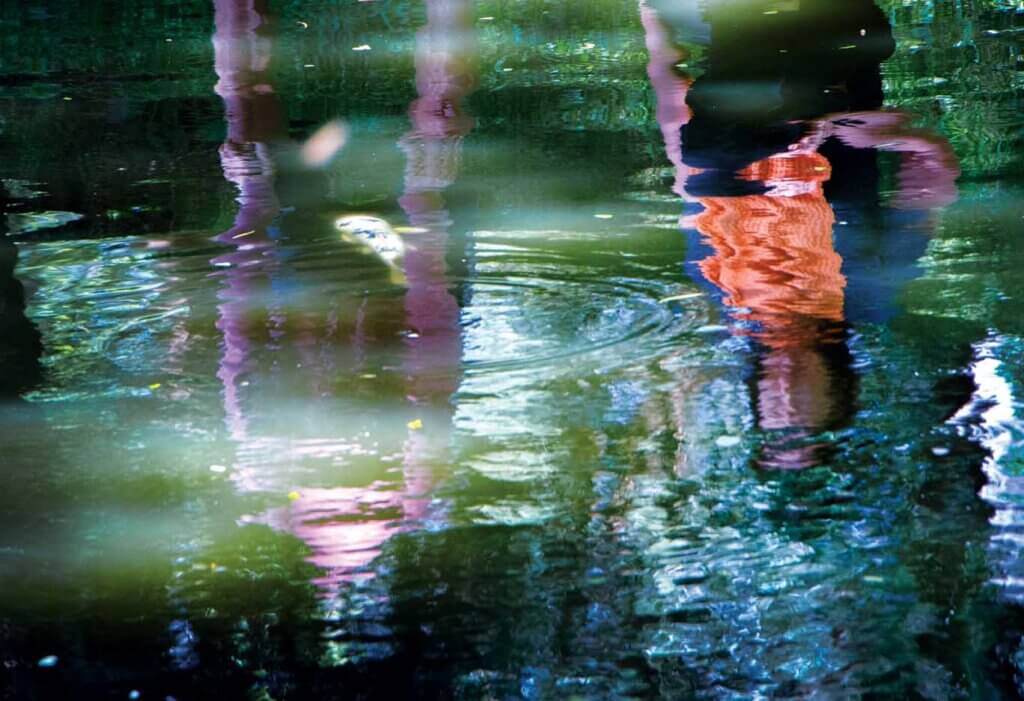

As a young photographer, I learned that you don’t have to see the big picture, but the small details of everyday life. The subject in a photo, whether you see their face or not, has the drive to keep going even when they face adversity. That drive that you see in every person inspires me to keep going too. When I’m faced with an obstacle, I think about the details around me and see how they can present an opportunity rather than a challenge.


Two fishermen are reflected in Inle Lake. Inle Lake, Burma / Myanmar, 2011.
Dreamlike reflections of two fishermen on Inle Lake, a freshwater lake in the highlands of Myanmar, where the fishermen row with one leg between floating gardens and stilt houses.
Jordan Quan ’25
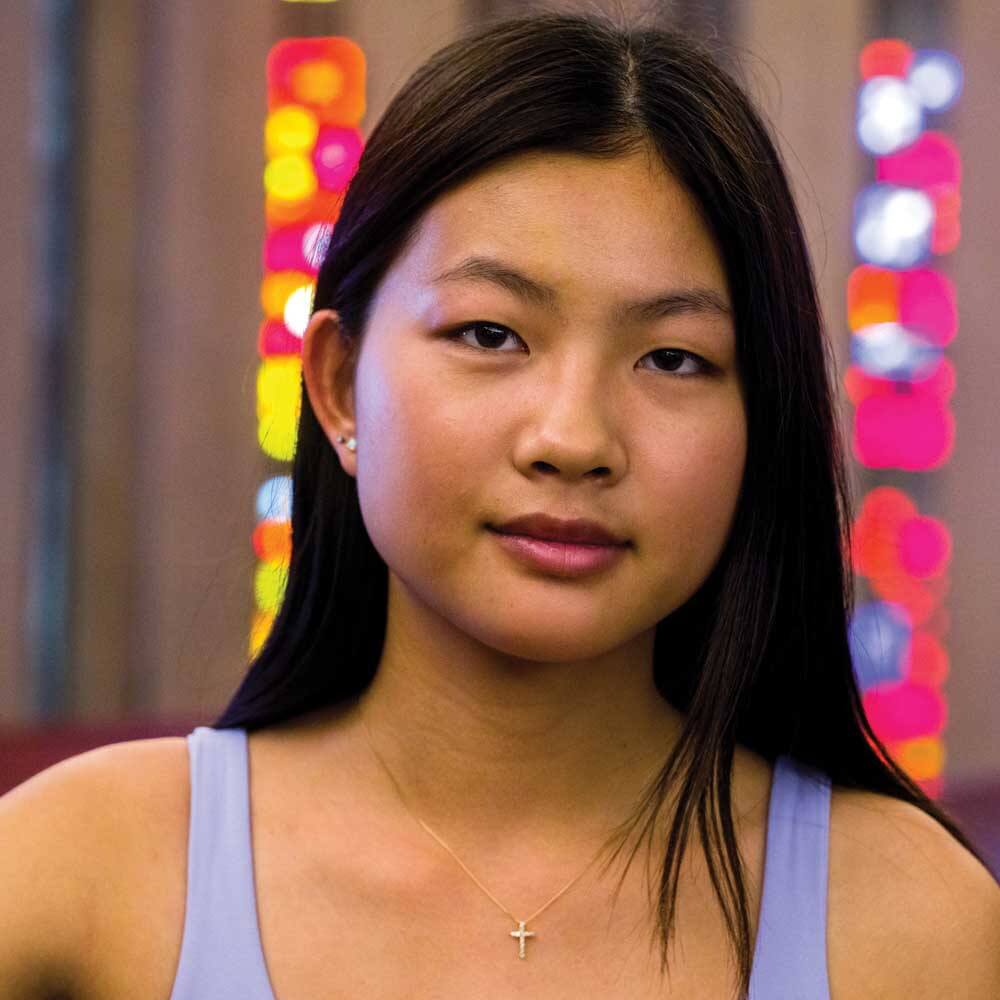

What attracted me to the photograph I chose by Steve McCurry was the unique use of color. I saw a wonderful opportunity to capture and share the similarities and differences between Hawaii and Madagascar – and how we had common ground despite the distance. I saw the way the woman in this photograph walked and presented herself, all the emotions I wanted to convey in my photograph.


The main technical aspect I wanted to emulate was the specific colors, lighting, and composition of the subject. I was able to do this by choosing a time of day that best mimicked Mr. McCurry’s use of the sun and incorporating my love of sunsets. Since I already had an idea of how to compose this photo, I knew exactly where I wanted to shoot it.
Through Mr. McCurry, I learned how to handle a camera in public and how to find the beauty in what you would normally call “ordinary.” I learned to trust my instincts and that framing the subject is incredibly important in getting the intended message across. A slight movement in any direction can really make or break the photo!
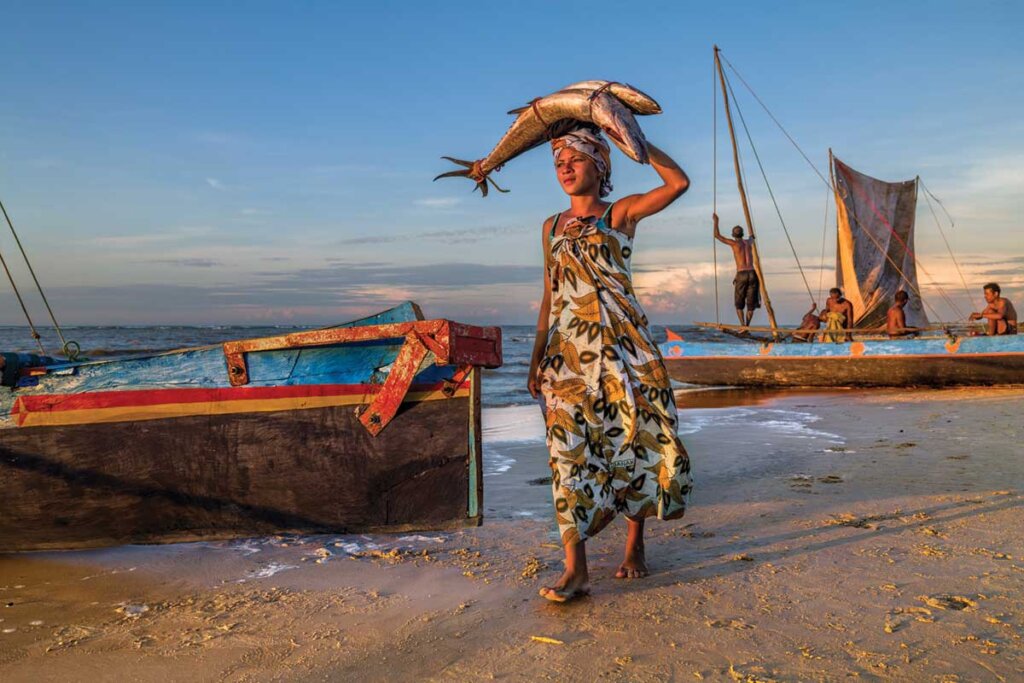

Woman carrying fish on the beach. Morondava, Belo Sur Mer, Madagascar, 2019.
Known for its pristine white sand, turquoise waters and vibrant coral reefs, Belo Sur Mer Beach in Madagascar offers a picturesque paradise for beach lovers and snorkelers. Nestled in a lush tropical setting, this idyllic coastal retreat attracts travelers seeking tranquility and natural beauty off the beaten track.
Nadia Allen ’24


Looking through Steve McCurry’s photographs, I was captivated by their bright colors and simplicity. They reminded me of sunsets on the beach with my friends. When I was given the task of interpreting one of his photos, I tried to demonstrate the use of similar colors and lighting. I studied his photos to determine the best location and time of day for my work.
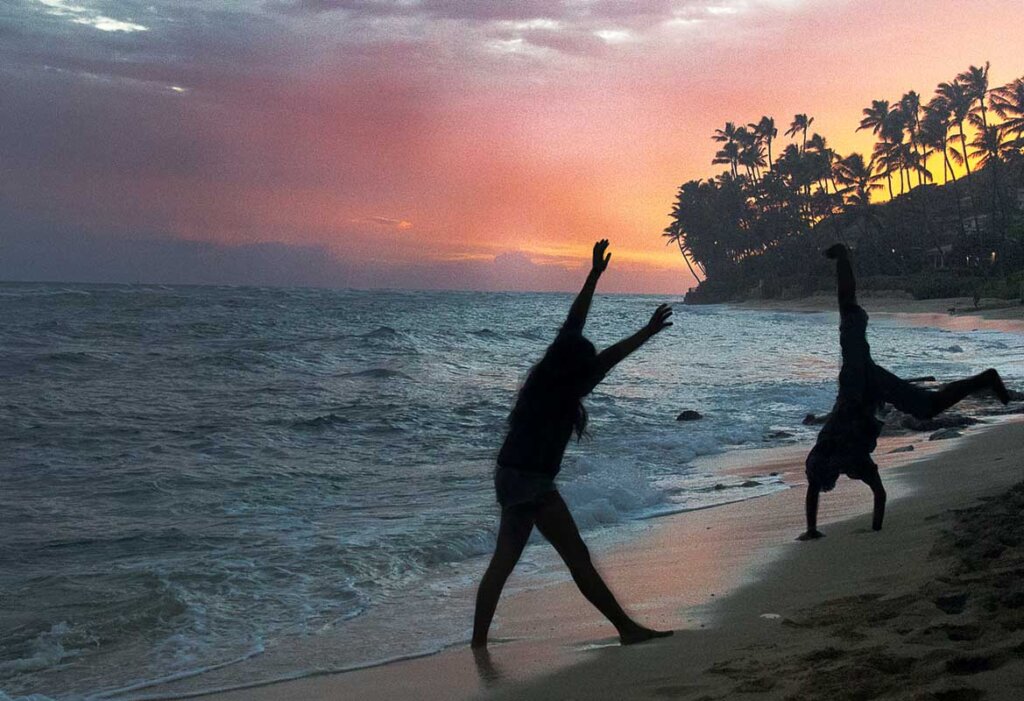

Through this experience, I learned that perspective is an essential element of this art form – you don’t focus on what’s wrong with a photo, but see the aspects that are unique and beautiful. I now know that even an accident can become a focal point and a topic of conversation. At first, I had difficulty recreating his work because I was so focused on making it exactly like his. But I began to realize that there is beauty in personal interpretation; a feeling that my work could be just as meaningful and impactful.
Mr. McCurry taught us that it is important to have a goal when taking photographs and to take the time to capture just the right moment. I think that is a valuable lesson in both photography and life; patience is the key to success.
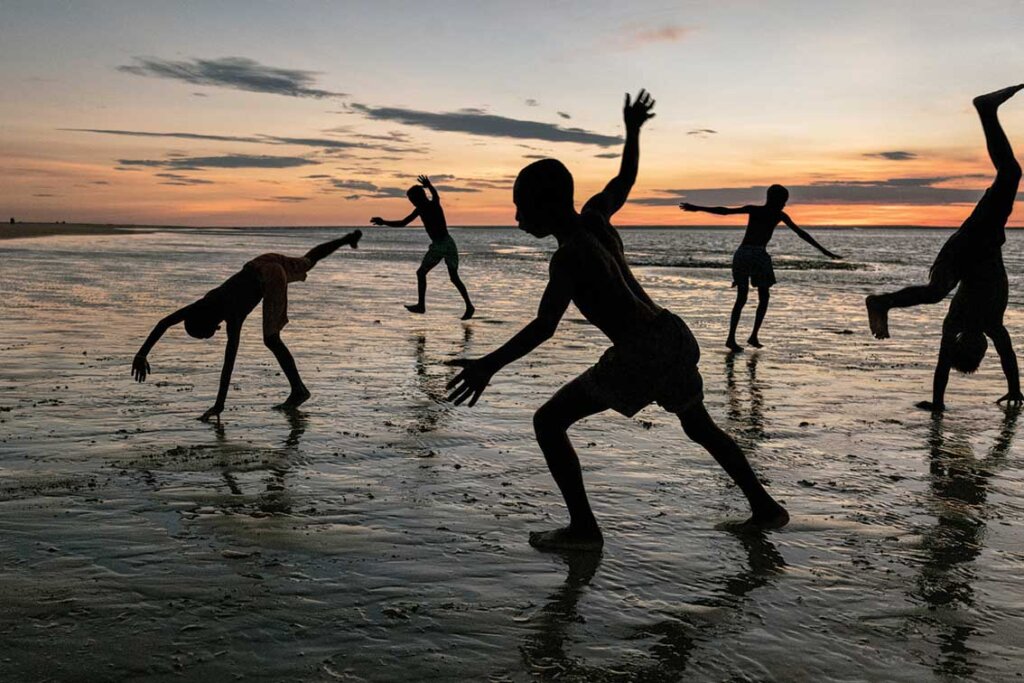

Children do cartwheels on the beach of Belo Sur Mer. Morondava, Madagascar, 2019.
The laughter of children fills the air as they do somersaults on the sandy beach, their energy reflecting the vibrant spirit of the island.
Jake Davidson ’27


The composition, lighting and reflections in the water are what drew me to the photograph I chose of two men walking along the bank of a canal in Venice. The lighting creates a mood by casting deep shadows and creating reflections in the water below. In the water there is a mirrored image of the buildings and the walkway above, bending and distorting the colors and lines.


I tried to recreate the reflections in the water and the framing of the subject. I managed to do this by using reflections in the lily pond and in the railing in front of the chapel – similar to those in Venice. The railing frames the subject according to the rule of thirds.
I learned the importance of good lighting and that you should take your time to get the image you want. You shouldn’t feel like you’re in a rush when taking photos.
What I love about Mr. McCurry’s photography is its timelessness – the viewer has no idea when his images were taken. I was surprised that images from the 1970s were indistinguishable from images from the 2010s. His work truly transcends time and language.


Man walking along canal. Venice, Italy, 2011.
The city of Venice has drawn me back so many times I’ve lost count. The Italian ethos is based on living life well and to the fullest. The fascinating synergy of the people and their surroundings creates an endless wealth of situations to photograph. Venice is a living museum unlike any other city in the world.

